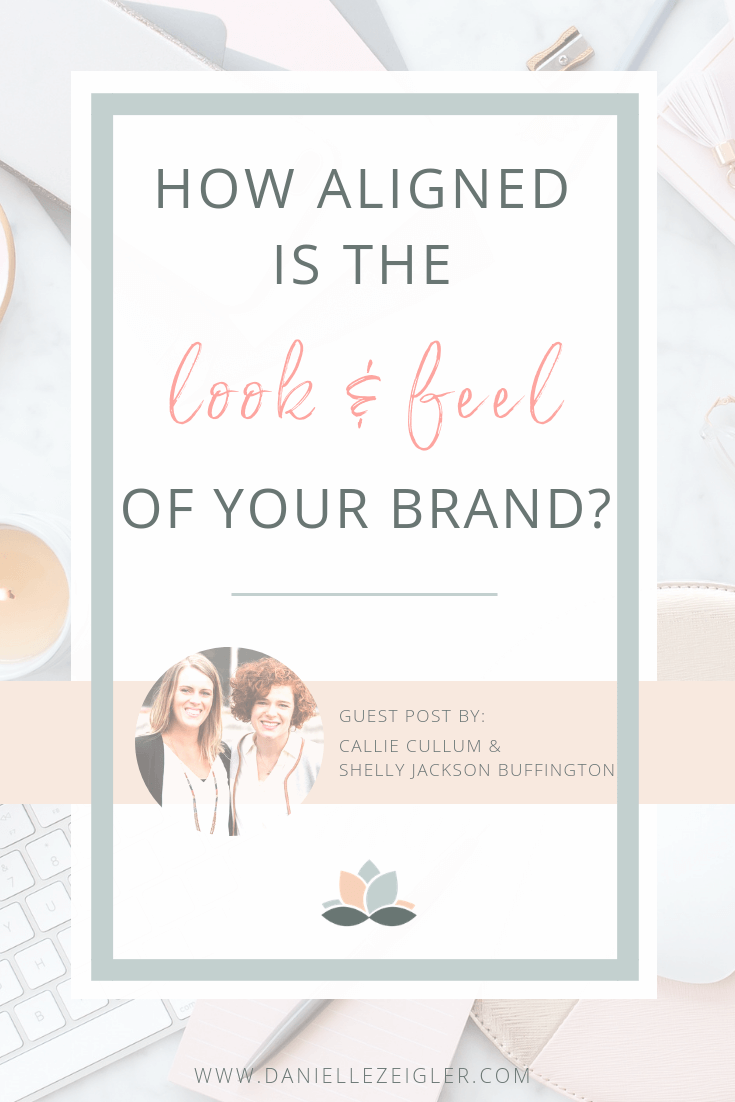How Aligned Is the Look and Feel of Your Brand?
/In this blog post, Callie Cullum & Shelly Jackson Buffington of The Look & The Feel walk you through a ten-step simple process to help you harmonize the look (visuals) and feel (voice) of your brand so that you have a clear, consistent, and cohesive business presence.
Connect your brand visuals and voice in 10 simple steps
A brand with a solid brand identity and story crafts compelling narratives and visuals that draw in the customer. Story-centered branding is all about being intentional and authentic so that you can create more thoughtful, compelling, and creative relationships with your customers. The reality is that, too often, a brand’s look and feel is off balance; the design may shine but the writing doesn’t hit the mark. Or perhaps the copy and messaging are tugging at the customers’ heartstrings but the graphics don’t support the sentiment.
It’s vitally important to maintain a cohesive, well-defined, and clear brand look and feel. Additionally, you want to make sure that once your look and feel is established, you maintain your brand’s consistency even as your business grows and evolves. The more consistent and cohesive your brand voice and visuals are, the more likely your customers will start to know, like, and trust your brand, offerings, and content.
Here are 10 steps you can take to maintain brand consistency for your business.
1. Understand and research your vision
Before you set out to do any work, you’ll want to identify your brand vision. To do this, consider the what, who, and why of your brand.
What are you offering?
Is your brand going to be providing a service?
Who is that service for?
Do you envision your brand having a happy, cheerful tone, or will it be more subdued and calm? Try to visualize what this may look and feel like.
Next, hop online and research other brands that inspire you.
Take notes of what you love about other brands; is it the colors they use?
Is it the language?
Do they stir a certain feeling for you?
Also be sure to look at brands that you don’t resonate with and make notes of what you don’t like about them.
Once you are able to identify your target audience, always think of your brand from their perspective and not simply what you like personally.
2. Develop your brand vocabulary
One foolproof way to create an authentic brand is to create a clear brand language. In order to stand out, your brand shouldn’t sound like everyone else in your industry. Tone of voice plays a huge role in how your customers perceive your brand. Plus, crafting content with your own distinct and recognizable voice helps differentiate your brand from competitors.
How do you want your brand to sound?
How would you describe the feeling you want your customer to experience when they engage with your brand?
What does your customer want to hear?
How do they want to be spoken to?
Are there specific words that your audience or potential customer commonly use in conversation about your services or product?
Brainstorm and create a word cloud of words that, when you read it, spark the specific feeling you want to share with your customer.
3. Create a moodboard
Now that you’ve done some research on your brand vision, gathered some notes, and developed your brand vocabulary, start to hone in on the images that really pull this all together. Creating a moodboard or inspiration board for your brand will help you stay consistent throughout all of your marketing materials. Doing this right off the bat will help you identify what common themes you are visually attracted to.
Pinterest is a great tool for doing this. Simply create a board, and pin anything that resonates with you. Once you’ve got a good collection of images, look for a common theme. Compare these themes with your brand vocabulary and see where the overlap is. Choose 5-8 that exemplify those themes the most, and you’ve got your moodboard! Use this as inspiration to inform the rest of your materials.
4. Identify your brand values
By articulating what your brand values can help you attract and retain the right customers. Your brand values can often be considered the core of your brand’s purpose. They help you navigate the “why” behind what you do, as well as help you develop the real personality behind your brand.
Start by making a list of what kind of emotions, feelings, experiences, ideologies, etc., with which you don’t want your brand affiliated. It can help to see what it is that we don’t want to align with before we solidify our values. Then, look at this list. What would be the opposite or contrast to that list? For example, maybe your brand doesn’t value high-tech or fast-fashion. Perhaps you prefer the DIY movement or the art of taking time to handcraft bespoke products or services. Remember, this is your list. There is no right or wrong way to create a brand values list.
5. Use your inspiration to create your visuals
Whether you are DIY-ing your brand or working with a professional, you’ll want to make sure your logo aligns with your brand vision and values. You’ll often hear branding agencies and designers alike touting the phrase “your brand is more than just your logo.” Hopefully, by now you can start to see why we are so adamant about this.
There’s so much that goes into your brand before you even start to create the actual visuals. Use everything from steps 1-4 to inform what your logo and brand style guide will look like. If you prefer elements of nature, maybe your brand visuals incorporate some soft greens and browns and shapes seen in the natural world.
Your brand visuals should evoke the thoughts, feelings, experiences, and ideas that your brand values. Doing this will help ensure that your branding will remain consistent throughout all of your visuals.
If you are DIY-ing, you can use tools like Canva to create a logo, but as always, we recommend that you invest in a professional when you can to ensure that your visuals are as precise and on-point as possible.
6. Call Out Your Brand’s Core Traits
Your customer wants to know why they should buy your particular product or hire you for a particular service. Tell them why you are the right brand for the job!
What makes your brand unique?
What makes you stand out from similar businesses in your industry?
Are you a brand new business with lots of enthusiasm to lead the way in your industry?
Or are you a seasoned veteran currently in the middle of a rebrand after two decades of running your business?
Do you offer really diverse services to accommodate a wider population with varied needs, or are you super focused with boutique offerings for a more tailored and personalized customer experience?
Look at what your brand specifically brings to the table, and then highlight those attributes to showcase your brand’s strengths, superpowers, and brand worth.
7. Clarify your story
You’ve probably heard the old saying that people like to purchase from people. The best way to ensure that your customer likes and trusts your brand is to familiarize them with your story. Now, when we say “story”, we don’t mean your biography, company bio, or your professional resume—we mean your honest story that has shaped you and the work you do.
Take some time to reflect on the following questions. If you have a team, ask everyone to consider these questions too!
What does it feel like to do the work you do?
Describe an experience that inspired you to live a creative and adventurous life.
Describe a daily ritual of yours that is related to your work.
What do you hope your customer gains when engaging with your work?
What’s the best piece of advice you’ve ever been given?
What makes you motivated to continue the work you’re doing?
Have fun with this! Pretend you’re being interviewed on your fave podcast. Share what excites you about your journey and see where it takes your inspiration.
8. Tell your story through your visuals
Now that you’ve done the work to discover your brand’s story and created your visual identity, you want to tell this story through all of your visuals.
If your story involves overcoming an obstacle, maybe you’ll want to use images on your website and social media of someone reaching the top of a mountain. Pull from the themes of your story to help inform your visuals. The most successful brands are those that are able to form a personal connection with their audience even before the customer makes a purchase.
Nowadays you hear more often than ever that people are invested in buying a story, not simply a product or service. Think about how you can tell your story visually and form that connection with your audience through your graphics. Never be afraid to put yourself out there; your clients want to know you and why you do the work you do. How can you show them who you are and what you value through your graphics?
9. Establish Your Messaging Goals
No one wants to be marketed to, and one easy way to sound sales-y or fake is to be too careless in how, when, and why you put out content to your audience. It’s super important to know what you want to share with your audience and why you want to share it.
Think about your particular customer audience and their specific needs:
What are they looking for? Are they in need of information to solve a specific problem?
Do they want to feel entertained or are they in search of certain information?
Or do they want to feel like they’re getting a good deal on a great product?
Maybe it’s all of the above. Your messaging goals should examine why, what, when, and how you share information with your customer. Review your brand values and brand vocabulary, and then decide how this can be incorporated into your communications. Use this information to help weigh your communications priorities so that you’re more deliberate and intentional with how you craft and share content.
10. Stay consistent!
Once you feel confident in your story, have your branding materials completed and don’t just store them in a folder somewhere and forget about them. Your branding should be evident in everything you create, from emails to potential clients to Instagram posts.
This is perhaps the most important step of them all. Brand consistency is absolutely vital to the success of your business. Always stick to your brand’s guidelines when creating more visuals or content for your brand so that you can build brand recognition.
Creating brand recognition with your audience will generate interest which leads to paying customers, and the only way to do that is to stay consistent throughout all your messaging and visuals.
There you have it! Ten intentional steps to take to be more purposeful as you align your brand voice and visuals. We hope that this helps you build your best brand.
DO YOU NEED HELP WITH DEVELOPING OR ALIGNING YOUR BRAND’S VOICE AND VISUALS?
We’d love to hear from you! Have you tried any of these suggestions? Where do you feel challenged or empowered in your branding efforts? Let us know in the comments below.
Get your free handy tip sheet to use as a reference for how to align your brand voice and visuals here.
About Look & Feel Branding
Callie Cullum & Shelly Jackson Buffington are the co-founders of The Look & The Feel, a full-service creative branding agency in Atlanta, GA and Lummi Island, WA. The Look & The Feel provides design, copywriting, business coaching, and brand strategy for creative and adventurous entrepreneurs.
Website // Instagram // Facebook // Pinterest













